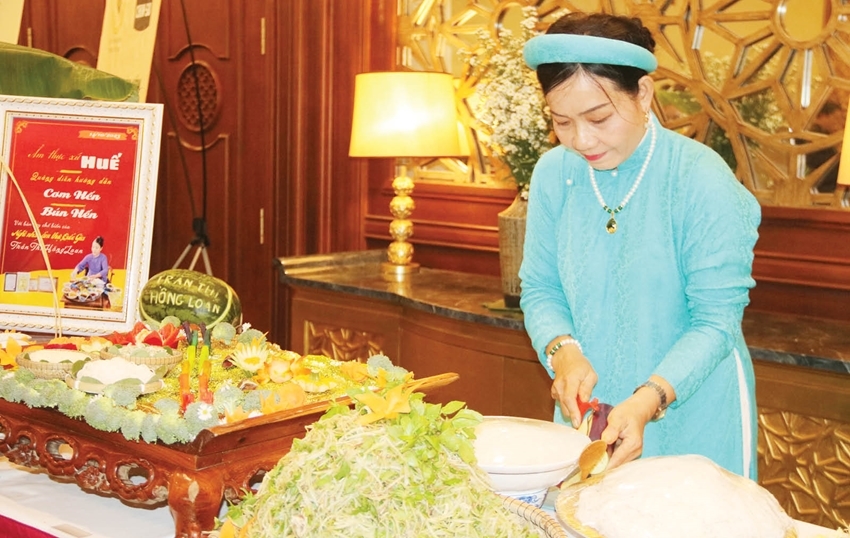 |
| Hue mussel rice and noodles being memorable dishes for many tourists |
Tourists are attracted to cuisine
Recently, the fact that Da Nang announced a series of culinary events themed “Vietnamese culinary journey” to promote Vietnamese cuisine to domestic and international tourists has attracted many people’s attention. This is the opening event for a series of activities in 2024 to implement the plan to develop cuisine tourism into a unique product in Da Nang in the period of 2023 - 2030. The locality’s desire is to create a series of culinary events to serve tourists, creating a competitive advantage to attract tourists. Indeed, tourists are very supportive of this trend.
The story of Da Nang is very close to that of Hue tourism. This is, nonetheless, not meant for making any comparisons between the two localities, for both Da Nang and Hue are contributing to promoting Vietnamese culinary culture. However, in fact, Hue has many recognized and honored dishes, which is an undeniable advantage. In 2023, in the “Journey to Search for Vietnamese Culinary Cultural Values”, Thua Thien Hue was the only locality to be honored with 6 dishes, namely Hue beef noodle soup (bun bo), tapioca dumplings stuffed with roasted pork sweet soup (che bot loc heo quay), mussel rice (com hen), tapioca dumplings (banh loc), mixed vegetarian fig salad, vegetarian rice steamed in lotus leaf, among 121 typical culinary dishes of the 3 regions. In the top 10 Asian records in 2023, Thua Thien Hue has 2 records established as Asian records: mussel rice as the specialty dish and sesame candy (me xung) as the specialty gift.
Hue cuisine is not only the pride of Hue people, but is also popular with tourists from all walks of life. Ms. Thao Nguyen, a tourist from Quang Nam, shared: “Honestly, Hue dishes are not only cheap but also delicious, rich, and diverse. In fact, one cannot try all the dishes at a time. Each region has different cuisines, but Hue cuisine is probably the most outstanding.”
Hue culinary resources act as one of the most competitive advantages in the tourism of the ancient capital. Hue cuisine accounts for more than 65% out of nearly 3,000 dishes in the country, with two main culinary genres being royal cuisine and folk cuisine. Mr. Vu Hoai Phuong, Vice President of Hue Culinary Culture Association, said that what had brought Hue culinary culture to an outstanding level included the diversity of sources and materials, from rustic to gourmet dishes, as well as the hands of artisans and chefs, from ordinary people to high-class aristocrats.
Such is the advantage, yet it hasn’t been exploited and incorporated into tourism to its full potential. A tourist said that tourists were attracted to Hue cuisine, but except for some popular dishes such as beef noodle soup, mussel rice and noodles, water-fern shaped rice cake with grilled shrimp (banh beo), flat steamed rice dumpling (banh nam), tapioca dumplings (banh loc), etc. There should be regular culinary events so that whenever tourists come to Hue, they can enjoy more delicious dishes that they have not tried on their previous trip.
Make the most of this advantage
In recent times, there have been a number of businesses incorporating the culinary elements into tourism products, yet they mainly only consider cuisine as an integrated part of the trip. A few culinary tours at the request of tourists only stop at the basic level of introducing some specialty and traditional dishes.
Currently, local authorities and the tourism industry are very interested in associating the culinary advantages with the development of tourism industry. However, the tourism industry needs to research into turning cuisine into a form of tourism just as the way destinations around the world are doing. Besides, it is possible to elevate Hue cuisine into a staple program during festivals or organize specialized culinary festivals. These festivals can converge the cuisine of the three regions and international cuisine, thereby exchanging cuisine and highlighting the uniqueness of Hue cuisine.
Local authorities and the provincial tourism industry need to research and organize culinary streets, creating culinary spaces bearing the mark of the Ancient Capital. There are already night streets in Hue City, where it is possible to consider forming beautifully planned food stalls to create a space to experience and enjoy Hue cuisine.
Mr. Le Tan, Vice Chairman of the Vietnam Culinary Culture Association, said that Hue culinary resources are very diverse and need to be associated with tourism development. To do that, the province needs to have investment policies for this field, with mechanisms to stimulate tourism demand and mechanisms to promote the role of participating culinary artisans.
“The tourism industry can organize famtrips (a type of travel for the purpose of exploring, understanding and marketing) in a systematic way via a detailed itinerary so that visitors can shop in markets like Dong Ba, associating shopping with story-telling. Besides, it is necessary to invest in cooperated professional food tours,” suggested Mr. Tan.
Hue cuisine is obviously diverse, which can be a basis for the tourism industry agencies and units to build large culinary programs and projects associated with the four seasons cuisine. Mr. Nguyen Van Phuc, Director of the Department of Tourism, said that the industry would continue to have more activities to exploit and enhance Hue cuisine in the near future.
